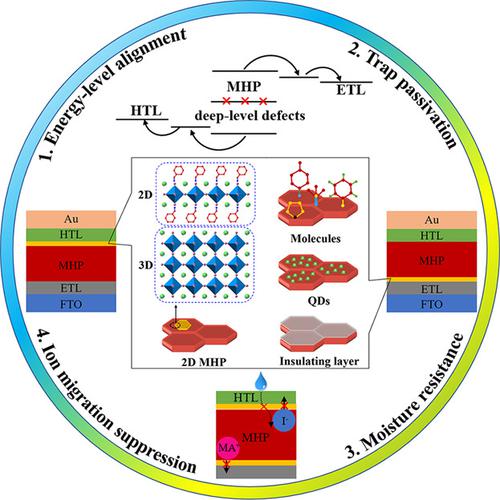Our official English website, www.x-mol.net, welcomes your
feedback! (Note: you will need to create a separate account there.)
Interface Engineering in n‐i‐p Metal Halide Perovskite Solar Cells
Solar RRL ( IF 6.0 ) Pub Date : 2018-09-04 , DOI: 10.1002/solr.201800177 Zhi Yang 1 , Jinjuan Dou 1 , Minqiang Wang 1
Solar RRL ( IF 6.0 ) Pub Date : 2018-09-04 , DOI: 10.1002/solr.201800177 Zhi Yang 1 , Jinjuan Dou 1 , Minqiang Wang 1
Affiliation

|
Recent years have witnessed continuous progress in metal halide perovskite (MHP) solar cells with a certified power conversion efficiency (PCE) exceeding 22%. However, the commercialization of MHP solar cells continues to encounter various challenges including stabilization, scalability and repeatability. Of all problems related to MHP materials, interface recombination is the most prominent, resulting in severe PCE loss within a short time. Fortunately, interface engineering has been identified as an efficient means of achieving better energy‐level alignment, reduced charge recombination, trap passivation, elimination of photocurrent hysteresis, and enhanced long‐term device stability. This review examines the relationship between specific interface modification layers and their roles in interface engineering based on device physics, revealed by several characterization methods. The latest research advances in interface modification layers according to their roles and properties are also summarized.
中文翻译:

n-i-p金属卤化物钙钛矿太阳能电池的界面工程
近年来,金属卤化物钙钛矿(MHP)太阳能电池取得了持续的进步,认证的功率转换效率(PCE)超过22%。然而,MHP太阳能电池的商业化继续遇到各种挑战,包括稳定性,可扩展性和可重复性。在与MHP材料有关的所有问题中,界面重组最为突出,导致短时间内PCE严重损失。幸运的是,接口工程已被视为实现更好的能级对准,减少的电荷复合,陷阱钝化,消除光电流滞后以及增强的长期器件稳定性的有效手段。这篇综述基于设备物理研究了特定的接口修改层及其在接口工程中的角色之间的关系,通过几种表征方法揭示出来。还根据接口修改层的作用和性质对接口修改层的最新研究进展进行了总结。
更新日期:2018-09-04
中文翻译:

n-i-p金属卤化物钙钛矿太阳能电池的界面工程
近年来,金属卤化物钙钛矿(MHP)太阳能电池取得了持续的进步,认证的功率转换效率(PCE)超过22%。然而,MHP太阳能电池的商业化继续遇到各种挑战,包括稳定性,可扩展性和可重复性。在与MHP材料有关的所有问题中,界面重组最为突出,导致短时间内PCE严重损失。幸运的是,接口工程已被视为实现更好的能级对准,减少的电荷复合,陷阱钝化,消除光电流滞后以及增强的长期器件稳定性的有效手段。这篇综述基于设备物理研究了特定的接口修改层及其在接口工程中的角色之间的关系,通过几种表征方法揭示出来。还根据接口修改层的作用和性质对接口修改层的最新研究进展进行了总结。















































 京公网安备 11010802027423号
京公网安备 11010802027423号